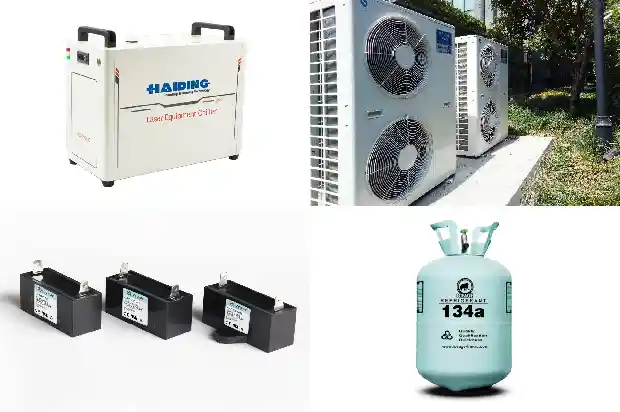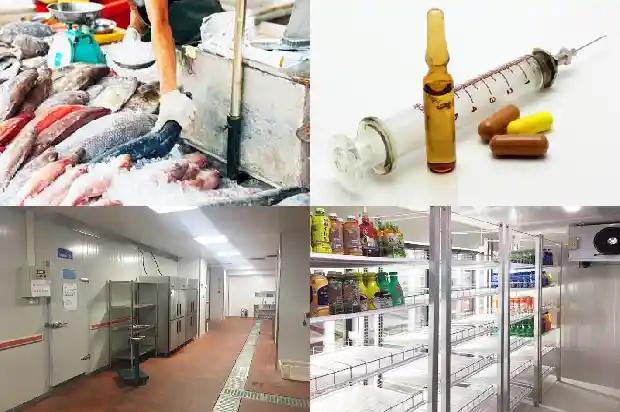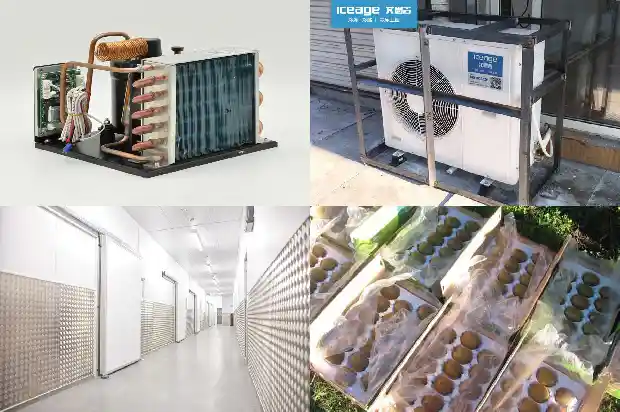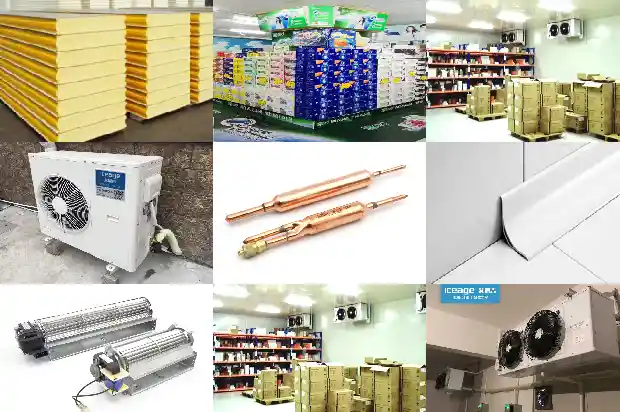Four Major Factors Affecting the Boiling Heat Transfer of Refrigerant Liquid
2025-03-11
In the evaporator, the heat of the cooled medium is transferred to the refrigerant through the heat transfer wall, causing the liquid refrigerant to absorb heat and vaporize. The phase change of the refrigerant in the evaporator is actually a boiling process, which is customarily referred to as evaporation.
The heat transfer temperature difference in the evaporator of the refrigeration device is not large, so the boiling of the refrigerant liquid is always in the bubble boiling state. When boiling, many bubbles are generated on the heat transfer surface.

So, what are the factors that affect the boiling heat transfer of the refrigerant liquid?
Let's analyze them one by one below. In fact, the boiling heat transfer coefficient is related to factors such as the size of the bubbles and the speed of the bubbles.
I. Influence of the Physical Properties of the Refrigerant Liquid
The physical properties of the refrigerant liquid, such as thermal conductivity, density, viscosity, and surface tension, have a direct impact on the boiling heat transfer coefficient.
For a refrigerant with a higher thermal conductivity, the thermal resistance in the heat transfer direction is smaller, and its boiling heat transfer coefficient is larger.
Under normal working conditions of the evaporator, the temperature difference between the refrigerant in the evaporator and the heat transfer wall surface is generally only 2 to 5°C. The intensity of the convective heat transfer depends on the degree of convective motion of the refrigerant liquid during the vaporization process.
During the boiling process, the movement of bubbles inside the liquid disturbs the liquid, which increases the possibility of contact between each part of the liquid and the heat transfer wall surface, making it easier for the liquid to absorb heat from the heat transfer wall surface and making the boiling process faster.
The greater the density and surface tension of the refrigerant liquid, the larger the diameter of the bubbles during the vaporization process, the longer the time from the generation of the bubbles to their departure from the heat transfer wall surface, the fewer the bubbles generated per unit time, and the smaller the heat transfer coefficient.
The thermal conductivity of Freon is smaller than that of ammonia, and its density, viscosity, and surface tension are all larger than those of ammonia. Therefore, its boiling heat transfer coefficient is smaller than that of ammonia.
The physical properties of the refrigerant liquid, such as thermal conductivity, density, viscosity, and surface tension, have a direct impact on the boiling heat transfer coefficient.
For a refrigerant with a higher thermal conductivity, the thermal resistance in the heat transfer direction is smaller, and its boiling heat transfer coefficient is larger.
Under normal working conditions of the evaporator, the temperature difference between the refrigerant in the evaporator and the heat transfer wall surface is generally only 2 to 5°C. The intensity of the convective heat transfer depends on the degree of convective motion of the refrigerant liquid during the vaporization process.
During the boiling process, the movement of bubbles inside the liquid disturbs the liquid, which increases the possibility of contact between each part of the liquid and the heat transfer wall surface, making it easier for the liquid to absorb heat from the heat transfer wall surface and making the boiling process faster.

The greater the density and surface tension of the refrigerant liquid, the larger the diameter of the bubbles during the vaporization process, the longer the time from the generation of the bubbles to their departure from the heat transfer wall surface, the fewer the bubbles generated per unit time, and the smaller the heat transfer coefficient.
The thermal conductivity of Freon is smaller than that of ammonia, and its density, viscosity, and surface tension are all larger than those of ammonia. Therefore, its boiling heat transfer coefficient is smaller than that of ammonia.
II. Influence of the Wetting Ability of the Refrigerant Liquid
If the refrigerant liquid has a strong wetting ability on the heat transfer surface, the bubbles generated during the boiling process have a small root and can quickly separate from the heat transfer surface, and the heat transfer coefficient is relatively large.
On the contrary, if the refrigerant liquid cannot wet the heat transfer surface well, the root of the formed bubble is very large, reducing the number of vaporization nuclei, and even forming an air film along the heat transfer surface, significantly reducing the heat transfer coefficient.
Several commonly used refrigerants are all wetting liquids, but the wetting ability of ammonia is much stronger than that of Freon.
If the refrigerant liquid has a strong wetting ability on the heat transfer surface, the bubbles generated during the boiling process have a small root and can quickly separate from the heat transfer surface, and the heat transfer coefficient is relatively large.
On the contrary, if the refrigerant liquid cannot wet the heat transfer surface well, the root of the formed bubble is very large, reducing the number of vaporization nuclei, and even forming an air film along the heat transfer surface, significantly reducing the heat transfer coefficient.
Several commonly used refrigerants are all wetting liquids, but the wetting ability of ammonia is much stronger than that of Freon.
III. Influence of the Boiling Temperature of the Refrigerant
During the boiling process of the refrigerant liquid, the more bubbles are generated per unit time on the heat transfer wall surface of the evaporator, the larger the boiling heat transfer coefficient. The number of bubbles generated per unit time is related to the time from the generation of the bubbles to their departure from the heat transfer wall surface. The shorter this time is, the more bubbles are generated per unit time. In addition, if the diameter of the bubbles when they leave the wall surface is smaller, the time from the generation to the departure of the bubbles will be shorter.
When the bubbles leave the wall surface, their diameter is determined by the balance between the buoyancy of the bubbles and the surface tension of the liquid. The buoyancy prompts the bubbles to leave the wall surface, while the surface tension of the liquid prevents the bubbles from leaving. The buoyancy of the bubbles and the surface tension of the liquid are also affected by the density difference (the density difference between the liquid and the vapor) at the saturated temperature. The buoyancy of the bubbles is directly proportional to the density difference. The surface tension of the liquid is proportional to the fourth power of the density difference.
Therefore, as the density difference increases, the growth rate of the surface tension of the liquid is much larger than the growth rate of the buoyancy of the bubbles. At this time, the bubbles can only maintain balance by expanding their volume, so the diameter of the bubbles when they leave the wall surface is large.
The above shows that in the same evaporator, when the same refrigerant is used, its heat transfer coefficient increases with the increase of the boiling temperature.
During the boiling process of the refrigerant liquid, the more bubbles are generated per unit time on the heat transfer wall surface of the evaporator, the larger the boiling heat transfer coefficient. The number of bubbles generated per unit time is related to the time from the generation of the bubbles to their departure from the heat transfer wall surface. The shorter this time is, the more bubbles are generated per unit time. In addition, if the diameter of the bubbles when they leave the wall surface is smaller, the time from the generation to the departure of the bubbles will be shorter.
When the bubbles leave the wall surface, their diameter is determined by the balance between the buoyancy of the bubbles and the surface tension of the liquid. The buoyancy prompts the bubbles to leave the wall surface, while the surface tension of the liquid prevents the bubbles from leaving. The buoyancy of the bubbles and the surface tension of the liquid are also affected by the density difference (the density difference between the liquid and the vapor) at the saturated temperature. The buoyancy of the bubbles is directly proportional to the density difference. The surface tension of the liquid is proportional to the fourth power of the density difference.
Therefore, as the density difference increases, the growth rate of the surface tension of the liquid is much larger than the growth rate of the buoyancy of the bubbles. At this time, the bubbles can only maintain balance by expanding their volume, so the diameter of the bubbles when they leave the wall surface is large.

The above shows that in the same evaporator, when the same refrigerant is used, its heat transfer coefficient increases with the increase of the boiling temperature.
IV. Influence of the Structure of the Evaporator
During the liquid boiling process, bubbles can only be generated on the heat transfer surface, and the effective heat transfer surface of the evaporator is the part in contact with the refrigerant liquid. Therefore, the magnitude of the boiling heat transfer coefficient is related to the structure of the evaporator.
Experimental results show that the boiling heat transfer coefficient on the finned tube is greater than that on the smooth tube, and that on the tube bundle is greater than that on a single tube.
This is because after adding fins, under the conditions of the same saturated temperature and heat load per unit area, the conditions for the generation and growth of bubbles are more favorable for the finned tube than for the smooth tube.
Due to the increase in the number of vaporization nuclei and the decrease in the growth rate of bubbles, the bubbles can easily separate from the heat transfer wall surface. Experimental results also show that the boiling heat transfer coefficient of the finned tube bundle is greater than that of the smooth tube bundle.
According to the above analysis, the structure of the evaporator should ensure that the refrigerant vapor can quickly separate from the heat transfer surface.
In order to effectively use the heat transfer surface, the vapor generated after the throttling of the liquid refrigerant should be separated from the liquid before entering the evaporator, and in the operation and management, the evaporator should maintain a reasonable flow rate of the refrigerant liquid.
In addition, the presence of oil in the refrigerant also has a certain impact on the boiling heat transfer coefficient, and the degree of its impact is related to the oil concentration.
Generally speaking, when the oil concentration in the refrigerant is not greater than 6%, this impact can be ignored. When the oil content is higher, it will reduce the boiling heat transfer coefficient.
During the liquid boiling process, bubbles can only be generated on the heat transfer surface, and the effective heat transfer surface of the evaporator is the part in contact with the refrigerant liquid. Therefore, the magnitude of the boiling heat transfer coefficient is related to the structure of the evaporator.
Experimental results show that the boiling heat transfer coefficient on the finned tube is greater than that on the smooth tube, and that on the tube bundle is greater than that on a single tube.
This is because after adding fins, under the conditions of the same saturated temperature and heat load per unit area, the conditions for the generation and growth of bubbles are more favorable for the finned tube than for the smooth tube.
Due to the increase in the number of vaporization nuclei and the decrease in the growth rate of bubbles, the bubbles can easily separate from the heat transfer wall surface. Experimental results also show that the boiling heat transfer coefficient of the finned tube bundle is greater than that of the smooth tube bundle.

According to the above analysis, the structure of the evaporator should ensure that the refrigerant vapor can quickly separate from the heat transfer surface.
In order to effectively use the heat transfer surface, the vapor generated after the throttling of the liquid refrigerant should be separated from the liquid before entering the evaporator, and in the operation and management, the evaporator should maintain a reasonable flow rate of the refrigerant liquid.
In addition, the presence of oil in the refrigerant also has a certain impact on the boiling heat transfer coefficient, and the degree of its impact is related to the oil concentration.
Generally speaking, when the oil concentration in the refrigerant is not greater than 6%, this impact can be ignored. When the oil content is higher, it will reduce the boiling heat transfer coefficient.
Related Articles
- What Factors Affect the Abnormal Operation of the Control Valve in the Cold Storage?
- What are the factors affecting large cold storages?
- Performance Comparison of Air-Cooled Heat Pumps, Multi-Split Systems and Water-Cooled Units
- ASHRAE Calculation of Cooling and Heating Loads
- Is the Compressor of the Cold Storage Unit Overheating? Find the Reasons Here!
- Why Does the Compressor Always Trigger the Overheat Protection?
- Analysis of Causes for Compressor Liquid Hammer, Overheating and Pre - heating
- Refrigeration Repair Techniques: A Must - Know - "Sub - cooling" and "Super - heating"
- Defrosting Heating Tubes in Refrigeration Devices
- Essential for Maintenance! Parameters and Phenomena of Normal Operation of Refrigeration and Heating Systems
- Principles, Components and Heat Recovery of Modular Units
- Considerations in Selecting Packaged Air Conditioners and Their Heat Recovery Operations
- Frosting and Defrosting Issues of Air - cooled Heat Pumps
- 9 Heating and Cooling Solutions: Pros and Cons You Must Know!
- Analysis and Troubleshooting of Common Faults in Air - source Heat Pumps
- Cleaning Procedures and Methods for Cooling Towers and Heat Exchangers
- What are the Cooling and Heating Pressures of an Air Conditioner? How to Calculate the Optimal Refrigerant Quantity?
- What Key Steps Should Not Be Ignored in Installing an Air - source Heat Pump Heating System?
